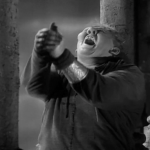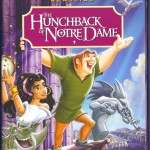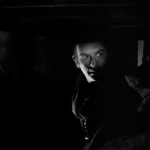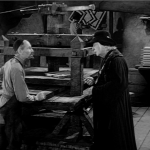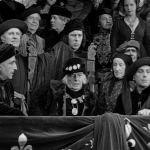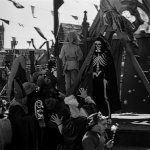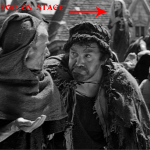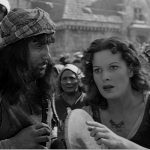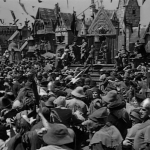In no particular order The Novel vs the 1939 Version of the Hunchback of Notre Dame
SPOILERS
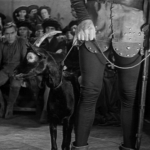
Aristotle the Miracle Goat 1939 Hunchback of Notre Dame
The Goat – Djali is not in every adaptations, so having a goat named Aristotle to fill in for Djali is not a big deal. But here the thing, Djali is a double for Esmeralda and they have a sisterly bond with each other but Aristotle seems more Gringoire’s goat than Esmeralda’s (the name Aristotle point more to Gringoire’s taste than Esmeralda’s). Also he comes into film out of no nowhere and exits just as quickly, the audience gets no closure on what become of Aristotle.
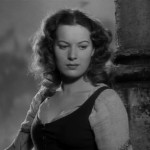
Esmeralda Maureen O’Hara 1939 Hunchback of Notre Dame
Esmeralda Doesn’t Die – It’s rare that Esmerlada actually kicks the bucket in the adaptations and if she does in fact live it’s because she’s paired up with a male, either Gringoire, Phoebus, or on rare occasions Quasimodo. If Esmerlada does die it’s beause like in the Book she leaves Notre Dame, if she stay put she lives, of course there are exceptions to this rule (albet not many) but this is typical order in Notre Dame adaptations. In the 1939 version she paired up with Gringoire.
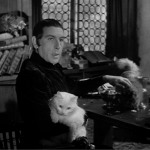
Frollo, the a crazy cat “lady?” Sir Cedric Hardwicke 1939 Hunchback of Notre Dame picture image
Frollo Loves Cats – This bit confounds me. Frollo’s office is full of cats. I have no clue where this comes from. In the book he has a “lab’ of sorts because he practices alchemy but it not full of cats. I’ve tried thinking of reasons why these couple seconds of film exist and here they are
- He trying to cover for his lie he told Esmeralda about that liking animals.
- He actually does like animals and this could the reason why he adopted Quasimodo in the first place.
- To show untrustworthy/evilness, cats are often used to illustrates with bad guys. But it’s not that necessary to show this, Frollo is a bigoted pervert, I think the audience got he was bad with out the visual aid of cats.
- To Show he’s Crazy.
There is no reason why his office should be fill of cats but it is and it not a accident, a movie just doesn’t fill up the sets with cats, there must be a reason or some inside joke.
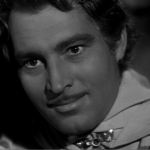
Phoebus (Alan Marshal) 1939 Hunchback of Notre Dame
Phoebus Dies – Most of the time like in the book Phoebus is not killed and no one really cares about that bit of information in the course of the trial but sometimes the accusation is enough. However in the 39 version he does dies and you the viewer are not suppose to care. It’s rare for Phoebus to die but this not the only adaptation where Phoebus dies.
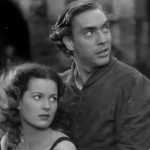
The Esmeralda and Gringoire, Maureen O’Hara, Edmond O’Brien 1939 Hunchback of Notre Dame
Esmeralda and Gringoire are in Love – Esmeralda and Gringoire develop a romantic interrest in each other. In the book they were “friends” Esmeralda like him enough but didn’t think much of him and he preferred Djali. He preferred Djali more that he saved Djali over Esmeralda leaving her in the hands of an insane Frollo while she is being hunted by guards.
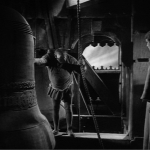
Bells of Notre Dame Charles Laughton Maureen O’Hara 1939 Hunchback of Notre Dame
Quasimodo has a Boy Bell – Kind of on the same lines as Frollo’s cats, it’s just a weird little add in. Quasimodo bell’s in book were ladies but in the 1939 version he has one boy bell “Guillaume” (French for William.) Consider that Quasimodo uses the bell in lieu of ladies, I guess this male bell is when Quasimodo is feeling curious.
(Edit 2104, there is a bell named Guillaume in the novel)
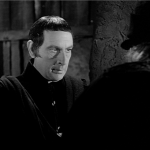
Jehan Frollo, Sir Cedric Hardwicke 1939 Hunchback of Notre Dame
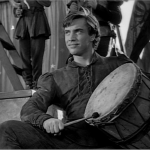
Gringoire, Edmond O’Brien 1939 Hunchback of Notre Dame
Frollo and Gringoire– In the book Frollo was Gringoire’s teacher, here they don’t even know each.
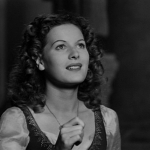
Esmeralda looking at the Virgin Mary, Maureen O’Hara 1939 Hunchback of Notre Dame
Esmerlda loves Notre Dame – In the 1939 version Esmeralda really seems to be a fan of the Virgin and here (to my knowledge) is the fist time she prays to her for her people (it started the trend). In the book she prays to Mary because she is afraid and being in Notre Dame she simply pray to the closet deity but that’s at the end of the book.
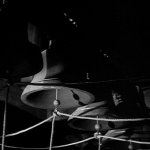
Bells 1939 Hunchback of Notre Dame
No Whistle – In the book Quasimodo gives Esmeralda a whistle just in case she ever needs him but in this film he tells her to just ring the bells. In both cases she take him up on his aid, but most adaptations go for the bells over the whistle, one less prop to deal with.
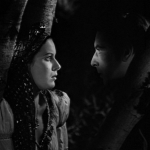
Frollo confesses his feelings to Esmeralda, Sir Cedric Hardwicke, Maureen O’Hara, 1939 Hunchback of Notre Dame
No Jail Scene -Ah, the jail scene, one my favorites, I tend to judge the adapations base off of this scene, well I wish I could because a lot the adaptations don’t have this scene or it’s very water down. The jail scene is when Frollo goes to Esmeralda whose in jail and confesses his confusion and torment for her. It’s a very long scene as Frollo gives a detail explanation of what his desire did to him and his actions as a result. In the 1939 movie the party scene or what I refer to as the “Tree Scene” fills in for the jail scene. Frollo corners Esmeralda against a tree and tells her that he basically confused, thinks about her all the time and can’t sleep. He doesn’t want people to see her dance and then threatens her. Doesn’t have the same impact as the book but at least it’s something.
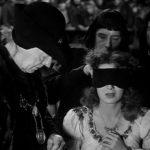
Trial by ordeal (chance) Esmeralda and Louis, Maureen O’Hara, Harry Davenport 1939 Hunchback of Notre Dame
The Interruptions during the Trial Scene – The trial puts me over the edge, there’re too many things that happen in the course of it. Quasimodo admits that he is the murder. I get why he does it; to show his love for her. But it a happens and goes way and is never mention again, seems to be a trend in this film. Then there is the Trial by Ordeal, for me this is even more off putting than Quasimodo’s interruption. The film loves Louis and uses any excuse to give him screen time. I get why he’s doing it; the Archdeacon asked him to but The Trail of Ordeal is more by chance, she blindfolded and must touch a dagger hers ( the guilty one ) or Louis’ (the innocent one), not much of ordeal and again it doesn’t amount to anything but at least its mention again by Louis so it doesn’t add anything other than Louis.
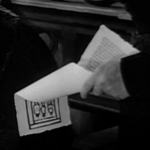
Gringoire’s Appeal for Esmeralda 1939 Hunchback of Notre Dame
The permits, petitions, & Nobles – At the beginning of the the 1939, we learn that Gypsies need a permit to live in Paris, Esmerlada doesn’t have said permit hence she seeks sanctuary towards the beginning of the film. In the book nobels are not a big deal and there are no petitions. In the 1939 version the Nobel are pissed that Esmeralda didn’t die because she killed “one of them’ so they make a petition to end sanctuary and also Gringoire makes an appeal to the king to free Esmeralda. In the book the whole sanctuary debacle is due to a rumor that Frollo made-up to get Esmeralda out of the cathedral and in his power, but the rumor went too far (ie the Court of Miracle attacks Notre Dame to save her and the Louis thinks it to an attack on him and orders for Esmeralda’s death, otherwise he wouldn’t have cared.)
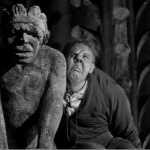
Quasimodo alone at the end, Charles Laughton, 1939 Hunchback of Notre Dame
Qusimodo alive at the end – Sometimes Quasimodo lives, sometimes he dies, and sometimes it’s implied that he dies. If he lives it can be sad because most of the time (two exceptions) he watches Esmeralda go off with another man, if he dies it can mean that in death he gets to be with Esmeralda like in the book, or if he dies then he dies and it’s sad. Quasimodo seldom gets a happy ending. In the 1939 not only does he live but he watches Esmeralda leave with Gringoire and he left alone to lament that he isn’t made of stone. Defiantly one of the more tragic endings for Quasimodo
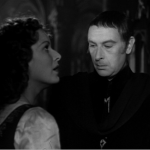
Frollo stares at Esmeralda’s chest for 15 seconds, Sir Cedric Hardwicke, Maureen O’Hara, 1939 Hunchback of Notre Dame
Frollo rounding up the Gypsy girls – So being a High Juctice, the 1939 version shows Frollo doing Justice-related tasks; going to meetings and being a judge. The film also shows him exercising some of his power, he rounds up all the Gypsy girls in order to find Esmeralda. This scene is meant to show his obsession for finding her. In the book he didn’t have the power to arrest people, he just stalks her old school style.
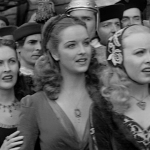
Noble Ladies 1939 Hunchback of Notre Dame
Nobles vs Beggars – The film mentions the clash between beggars and nobles and that the noble are just thieves that plunder countries while beggars engage in petty crimes. This clash is no where in the book and really is just in this one adapations. So basically the movie hates nobles.
Next time conclusions+

